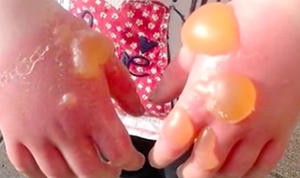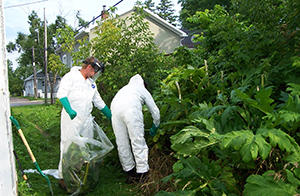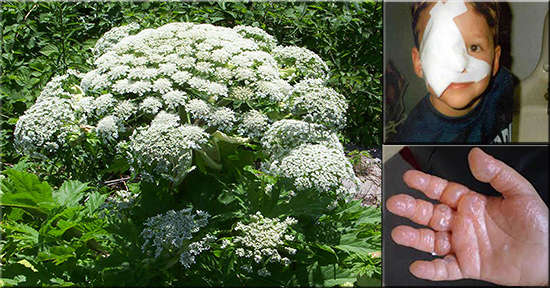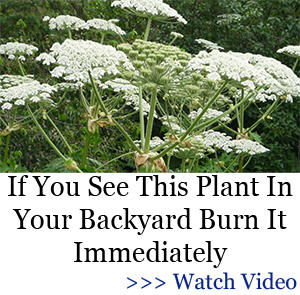This plant is called giant hogweed and buds pretty white flowers that give it an altogether innocuous look. Folks, make no mistake touching this plant!
Kids are in danger because they are more curious.
They should teach this in schools. There are only 10 plants in north america (excluding fungi) that kids need to know to avoid. So sad that kids aren’t taught basic things like this… or like what poison oak looks like.
Related: 19 Survival Skills You Should Teach your Children This Summer
Although part of the Carrot family, the giant hogweed can grow up to 14 feet tall and has a deadly toxic sap!
 If you brush up against this plant, accidentally break the stem or touch any of its sap that may be on it already you will get powerful blisters! The stem is quite tall so this is very easy to do and this applies to any part of your body with skin! The stems are green with patches of purple and is a bit hairy, filled with white hairs so you have an idea of what to avoid.
If you brush up against this plant, accidentally break the stem or touch any of its sap that may be on it already you will get powerful blisters! The stem is quite tall so this is very easy to do and this applies to any part of your body with skin! The stems are green with patches of purple and is a bit hairy, filled with white hairs so you have an idea of what to avoid.
What Will It Do To You?
If you come into contact with the plant’s sap you can expect sever blistering, possible blindness f it comes into contact with your eyes and possible third degree burns. These effects come from the type of chemicals that it contains. When these chemicals come in contact with human skin they dramatically increase the skins sensitivity to light.
This can cause blisters that are actually very painful and form within around 48 hours and can last from anywhere between a few months to six years. It can cause LONG TERM sensitivity to light if the sap gets in the eye.
Get My Free Book: The Medicinal Plant Guide That Should Be In Your Bug Out Bag
What to Do If You Or Your Child Come In Contact With It?
The best prevention is of course to avoid it!
But if you come into contact with the plant you should wash with cold water immediately as the toxic reaction can begin within 15 minutes after contact and get the heck out of the sun.
Apply sunblock/sunscreen on the affected area if you are in an outdoor situation with no way to get indoors for a while.
If the same sap gets into your eyes, rinse and make sure all of it is out of the eye. Then wear sunglasses to reduce sensitivity.
If you look at the hands in the first photo you will see a photo of a 10 year old girl that was infected by this plant. As you can see the blisters in the photo are enormous and the rest of her hand is swollen.
The little girl is from Scotland, but don’t “worry”, the plant grows as well in USA and Canada.
Recently there were public warnings about the plant and the serious problems caused by coming in contact with it. New York, Maryland, Virginia, Oregon ,Ohio, Washington, Pennsylvania, Michigan and some other states are reporting sightings of the plant.

How to Get Rid Of This Pest
Well conventional wisdom would say cut it down and maybe spray some weed killer on it. Think again, this will possibly just spread seeds and create a few more toxic plants. You may also be exposed to the toxic sap that is the whole cause of the fear of this plant.
The best advice if this plant is near to your home or on your land is to call EPA (United States Environmental Protection Agency) hotline – 1-800-424-8802 or your individual state agency in order to remove this plant as it is on the radar of many countries, and is considered a pest.
You may also like:
This Bug Will Kill Most Families During the Next Crisis (Video)
H2O Dynamo – The Awesome Device That Turns Air Into Water
This Can be the End of America as we Know it (Video)
This Common Driveway Weed is One of Nature’s Most Powerful Survival Plants
















The scientific name would be helpful as common names can vary by region. Some better pics of the plant/leaves for ID purposes would have been nice, as well as a map of its native region and the kind of habitat it tends to grow in.
Instead of being critical, just be proactive and google it.
how was your criticism either positive, proactive, or helpful?
check your back porch, binky.
Real nice. Not everyone Googles everything. If they did, why would we need blogs? And there is nothing wrong with providing helpful feedback. In fact, most websites welcome comments to improve their articles….that way people don’t have to Google it! Practice what you preach with YOUR negative comment!
google! handy but imperfect..An old Eastern European FARM guide , in this case..(when you fiind google WRONG, i hope it didnt cost A LIFE lost.
Thanks for the feedback. I’ll add some larger pics. The scientific name of the plant is Heracleum Mantegazzianum also called giant hogweed,cartwheel-flower, giant cow parsnip, hogsbane or giant cow parsley
Thanks for the heads up!
id be interested in your guide. /&any i know, you are welcome too./ MANY deadly plants , in USA; Most are classed as “medicinals”;( arnica montana-“wolfbane”….basis of homeopathy..5red berries will stop an adults lungs functioning.& kids GO for it.Lucky, it is 8′-12’tall and not Overly common.Be Safe.Thank You, i will beware in the Baltics ! O:-)
You might want to learn how to id plants BEFORE you publish a book on it. You will end up killing people by giving them bad advice and or misidentifying plants.
Would you please send a copy of the free copy of The Medicinal Plant Guide thank you Raymond Rigolo 16402 Framingham Circle Pflugerville, Texas thank you.
Would please send me a copy of the free Medicinal Plant Guide to: Milagrosa Lopez, Urb. Tropical Beach, 62 Calle D, Naguabo PR 00718-2712, thank you very much.
could someone build a fence of this plant, how soon does the blisters show up?
i thought the Same; mixed in with wild Bradford pear(2″ thorns), more disabling than razor wire..A GOOD addition if you can control it’s spread….(though ive Yet to encounter it)..
The bugs that like the flowers such as bees would pollinate other plants, and they would grow more. Also, the wind could blow seeds that are in the flowers
Good comments and good information too. However, you stated earlier “avoid it”, and teach your youngsters how to ID the plant and what to do if affected by it.
But please stop the knee jerk reaction of destroy and Eradicate. That’s so USA! It’s got it’s place in the wilds, so leave it be. Educate, not eradicate.
Sounds to me like someone could really use an organic SALAD right about now!!!
Would you please send a copy of the free copy of The Medicinal Plant Guide to: 21323 Hadrian Drive, Katy TX 77449, thank you.
I’ve never seen worse blisters anywhere than the pictures in this article! Fortunately my area in MA. does not have this plant, that I know of. Sure looks harmless. I have a weed in my yard that seems to only “poison” me. It’s called a “Day Flower”. Long, tall, green and spindly. Around this time of the year (August) it gets pretty blue little flowers… that’s the time of danger!!! After 9 days of blisters coming out all over my body, including areas that had no contact with the plant, it finally seems to be subsiding. Whew!! I’m safe as long as there are no flowers.
I don’t know if you found this information about the plant, but it actually IS in your neck of the woods I think.
https://en.wikipedia.org/wiki/Heracleum_mantegazzianum
I’m sure there’s no need for wide-spread panic, but if you’re a nature junkie, knowing what to look for while you’re out and about is probably a good idea!
there are many of these plants in kareila part of Russia, so many, the farmers just leave them or tractor them down, we are warned not to touch these plants, now we see why, the plants run all along the forest highways…
Hi, it is good to know bro. And to learn thing of how people done thing before, but hope the prepper info never is needed, hope all in the world keep these thing in their hearts! donaldbergsr@nc.rr.com I just like reading and keeping his info in mind, and pray it is never needed. I commented as as see your in Russia, I’m in the USA, peace and joy ! Donald
Id like to know about all poisonous plants.
If you are really mailing out those medicinal plant guides I would be grateful to have one also, thank you. Helen Jones, 15012 Jacks Pond Rd. Austin, TX 78728
How about a better picture of it genius
Is this plant grown all over the country or in just certain places? It would be helpful to know where to find this. Thank you.
RI./NH/Me/Vt/CT/Mass/Va/nola /Wisc… i may be immune or the plant i KNOW of that name isnt YOUR “import”?? NEVER trust “google”, or A book..RESEARCH the HELL out of it ! Find a Witness who can SHOW you!!!.(what is the Poison? p.oak, p.ivy, p.sumac, w/in 4 hours, wash with ammonia or lye soap& you probably wont react/ the lye mixes with the oil & washes away..THANKS.I will be researching..58years in the wood/field..etc,& ill never learn it all..(WIKIPEDIA, made-up “truth”?? ive seen PIX of “Bigfoot”,too)..WHERE did this originate? Eastern Europe? Ithanks again.
Is lye soap the same as the old fashioned “yellow soap” that my grandmother had us use if we got into poison ivy? I think (but may be wrong) that it also said Fels Napha on the label.
If pictures of these plants and of other important information is presented on playing cards they could be a valuable method of instruction.
This plant has sprang up in many nations where it hasn’t been before. My question is why? It clearly has been planted with the intent to do harm. Northern Ireland. an island isolated with a wind direction it doesn’t even have mosquitoes. The thought that the seeds are carried on the wind is false. This plant is an assault and should be treated as such. The solution for my cousins was to burn the plant with flame throwers on the ground with the ground subject to a burn again in the spring The dirt turned and treated with fire many times for two years. only then did they rid the area of the hog weed.
Grampa
There could have been someone that carried a seed as a joke, or perhaps an animal had a seed on it’s fur and brought it to other regions
Good information. Thank you for sharing. If book is still available, please send to 703 NW Midland Ave. Grants Pass, OR. 97526 or email to cmcdolphin@gmail
I’m glad to see this information; we have ‘hogweed’ here, but not the giant version. I Hope!!! Would like to have your book if it is still available. Thank you. CDS
I’ve had it for the 4th year now. I live in Wilsonville, Al. It started at my barn 4 years ago. We cut it with machetes and ax. It was higher that the tin roof. It caused blisters and burning above glove line. I finally got rid of that but it has come up in 2 other places in the pasture. I sprayed it with herbicide that would not hurt horses when it first starts. It seems to grow very fast. I had never seen it before 4 years ago. Now I see it everywhere.
how does this spread? I never seen this growing up in Michigan or Canada. I have relatives in Ireland that had contact with it. is it spread intentionally? This is the perfect terror item. easy to import and imposable to detect…….Grampa
do goats eat this (with impunity) as they do with poison ivy?
Looks like a big head of cauliflower (at least that’s how I’ll remember it)
The danger comes AFTER exposure to UV light. It has an equally dangerous cousin, widespread in the state of Vermont, USA, Blisterweed/Wild Parsnip/Cow Parsnip. It is much smaller, has yellow-green flower heads and loves disturbed soil like roadsides and ditches. Lots in PA, NY, NJ and MD. For some reason (I think political) it is not a federally reportable weed like Hogweed but, boy, can it do the same damage. These blisters can take years to heal, if ever, and can kill. Seeds are viable for 7 years, so, attack with vinegar/soap early and revisit yearly, folks, if on your patch.
This is ONLY to those sensitive to wild parsnip.
I for one have no problem even in sunlight. Hog weed on the otherhand affects everyone and is identified differently and MUCH LARGER!
So may sound stupid, but if it is that toxic and you don’t have young kids around, I wonder if it could be used as a first line of defense (ie around perimeter of your property) when SHTF….granted, its not fast acting….BUT, if someone were sneaking through your property to attack your house, and it starts kicking in around 15 minutes, I could see it being useful by the time they reached your house, especially if you lived on property in excess of a couple of acres…AND could see it being a long term deterrent….if you are blind and blistered, you arent coming back again and are a lot easier for me to stop/disable while defending myself….and if you were affected by it while trespassing, you kind of deserve what you get….AND, I might not HAVE to kill you to defend myself….which is one less burden to add to my consciousness later on…..kind of like the blister agents used in other times….just a thought.